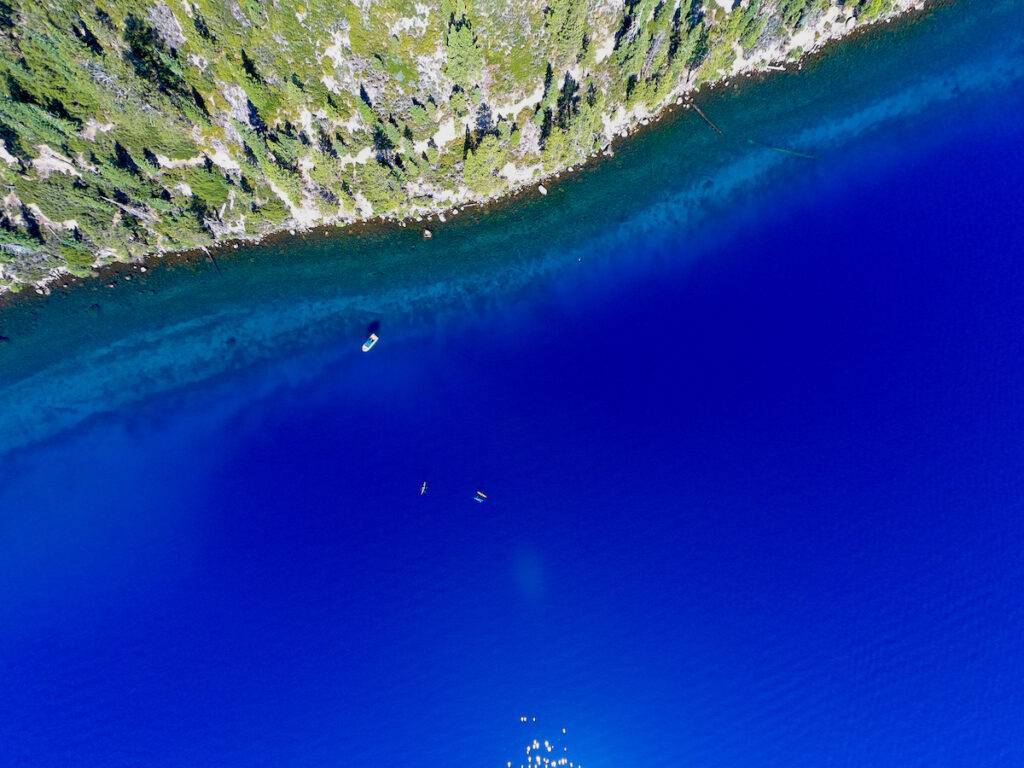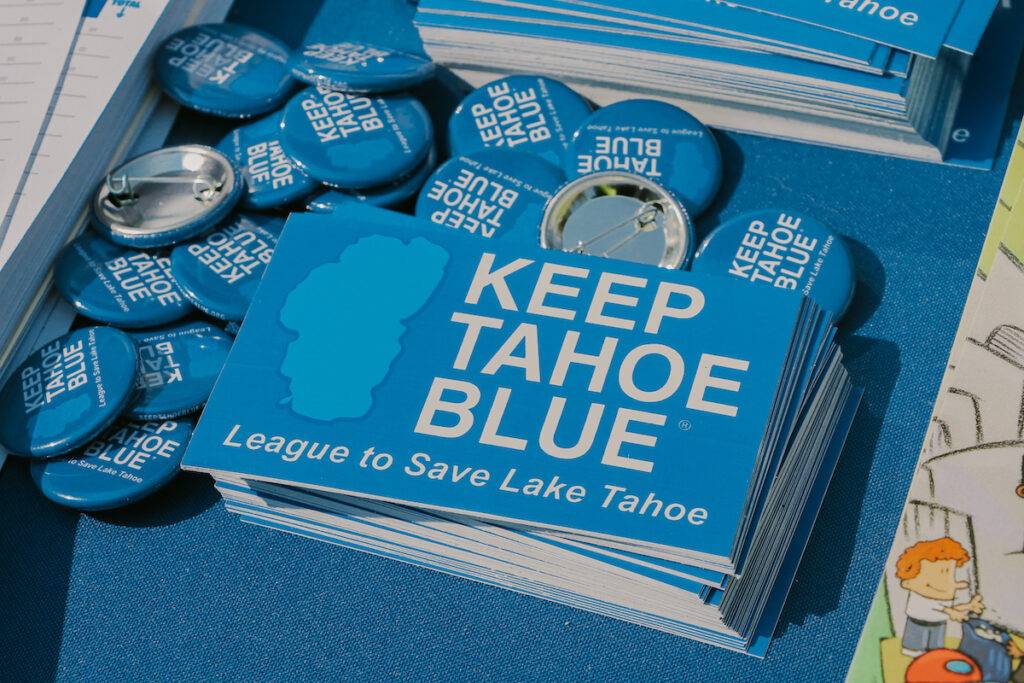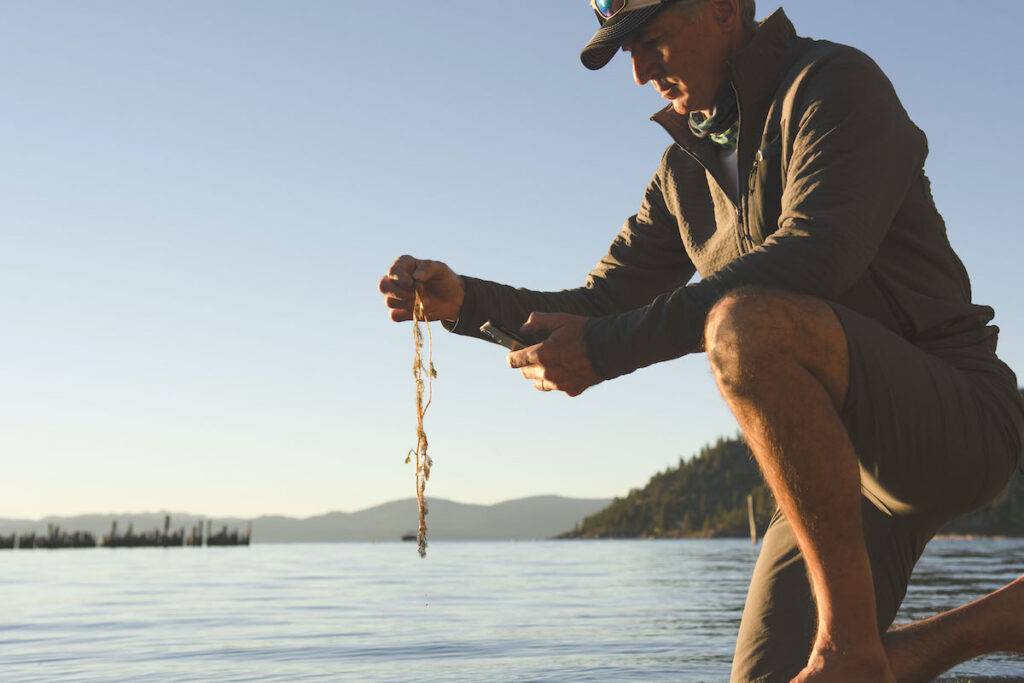A three-word slogan — Keep Tahoe Blue — has become the rallying cry of the League to Save Lake Tahoe and offers a blueprint for others around the world.
In late 1954, Dwight D. Eisenhower was in the White House, Roger Bannister had broken the four-minute mile, and Alexander Cochrane Cushing had a fanciful idea.
Cushing was the co-founder of what was then called the Squaw Valley* ski area, a small resort on the western shore of Lake Tahoe that offered some of the steepest, most challenging terrain in the U.S. Undeterred by his resort’s relative obscurity, particularly when stacked against global ski centers such as Innsbruck, Austria, or Chamonix, France, Cushing decided that Squaw Valley should bid to host the 1960 Winter Olympic Games.
It seemed a laughable proposal. Legend has it that Cushing himself was motivated strictly by the publicity that would surround an underdog bid. After all, there was little there, beyond Cushing’s charming but tiny resort and two year-round families. But Cushing had powerful — and wealthy — friends, and he organized a team and raised funds. A few years later, to the surprise of many (including perhaps himself), he won.
To ready itself for the world’s eyes, Tahoe began building.
Along with an Olympic Village, and, eventually, the completion of the four-lane I-80, the development around Lake Tahoe included the Tahoe Keys subdivision, built by dredging the western half of the Upper Truckee Marsh. Wetlands play a crucial role in watersheds, and this particular one filtered much of the water that made its way into the lake, in addition to providing habitat for birds, fish, and other wildlife.
But, while many celebrated this unbridled development as a sign of prosperity and progress, a local attorney named Bill Evers saw something else: the paving over of a paradise. In 1957, Evers, who’d graduated from UC Berkeley just five years earlier, fought back by creating an advocacy group, the Tahoe Improvement and Conservation Association (later the League to Save Lake Tahoe). “There was a lot of pushback,” says Jesse Patterson, the League’s current Chief Strategy Officer. After all, he says, the environmental movement was at least a decade away. There was no Endangered Species Act, no Clean Water Act, no oil spill in Santa Barbara. Rather, that time period was a heyday for developers. “You went and you built stuff and made money and enjoyed the place,” Patterson says. “And there were no rules saying anyone was doing anything wrong.”
Evers’ group coalesced around one major proposal — a plan to build a four-lane freeway around the entire lake with a bridge over Emerald Bay. “Our founders, who fortunately were well connected, said ‘no’,” Patterson says, “and were able to stop that project.”
Science has always been the League’s “North Star,” Patterson says, recalling that Dr. Charles Goldman, founder of the Tahoe Environmental Research Center, was working with the League in the 50s to demonstrate the loss of water clarity. Dr. Goldman blamed nutrient inputs and runoff, predominantly from septic systems and roads. “The environmental degradation was happening,” Patterson says, “but nobody could see it yet, except for the scientists.” But that science became a powerful tool that the League used to advocate for Lake Tahoe, helping them, for example, to win a fight to divert all sewage out of the lake.
That win led to more, including, in 1969, the creation of the Tahoe Regional Planning Agency, a government organization with unique authority over the Lake Tahoe watershed, empowered to develop rules that applied to both abutting states (California and Nevada) and all the counties within the Tahoe basin.
This, however, inspired more resistance. “You can imagine that the local counties and cities were like, ‘hell no, I’m not going to follow your rules’,” Patterson says, “but the lake doesn’t care what county or what state you’re in, or what city. It all affects the lake.”
Battles ensued, in and outside the courtroom, but development mostly surged ahead.
By 1973, Tahoe was poised to become another Vegas with a number of proposed casino expansions. Rules tilted in favor of development left Evers’ group essentially impotent to stop them. But that same year, someone — whomever it was is lost to history — coined a slogan that distilled the work of Evers and his group into three words on a sticker featuring the silhouette of the iconic lake: Keep Tahoe Blue.
Lake Tahoe was dazzlingly, famously blue. “The clearer the water, the deeper the light penetrates,” Jesse Patterson explains. “What you’re left with is a deep, rich blue, almost purple. You see photos of Tahoe and it looked photoshopped.”
To understand the power of those three words, we need to know that Tahoe was dazzlingly, famously blue. “The clearer the water, the deeper the light penetrates,” Patterson explains. “What you’re left with is a deep, rich blue, almost purple. You see photos of Tahoe and it looked photoshopped.”
Lake Tahoe plunges to a depth of 1,646 feet, making it the second deepest lake in the country and the tenth deepest in the world. It is also among the clearest, reflecting the sky on a sunny day and dazzling onlookers with its cobalt color. Keep Tahoe Blue was a clarion call to preserve this precious jewel before it dulled. It united everyone in a single goal.
The slogan caught on: Keep Tahoe Blue stickers made their way around the world and galvanized many into Tahoe’s protection. A few years, a handful of lawsuits, and a global recession later, a moratorium was declared on all development in the area.
“The economy crumbled,” Patterson says. “People lost their jobs, it was horrible.” But the pause it created allowed regulations to catch up, so when development ramped up again, it was in a much more regulated manner.
By this point, however, Lake Tahoe’s past was also catching up: its famous clarity was under threat, and the damage was apparent even to non-scientists. The sticker, for all its resonance, hadn’t kept Tahoe blue. Neither had the regulations. More had to be done.
The founders of the League to Save Lake Tahoe and the Tahoe Regional Planning Agency put together a broad coalition. “One shared vision, one set of guidelines,” Patterson says. In 1997, this coalition went straight to the top, inviting then-President Bill Clinton and Vice-President Al Gore for a five-day forum with the goal of kickstarting a restoration of Tahoe’s meadows, marshes, and forests. The effort paid off, leading to a $3 billion investment of public and private funds — all dedicated, says Patterson, “to undoing the mistakes of the past.”
Saving Tahoe became an all-hands-on-deck movement, enlisting everyone in the mission. A major goal, according to Patterson, was to turn those who might be perceived as the enemy into heroes for helping to fix a problem. But finding common ground among people and industries was complicated by the fact that Tahoe is situated in two different states; California and Nevada historically have had dramatically different political values and environmental protections.
“[We] had to bring people together that were vastly different in political ideologies and other ideologies [to] have more productive conversations about what to do,” Patterson says. Again, it paid off to remind everyone that they all had a stake in keeping Tahoe blue, even if it might be only an emotional one.
Even just a decade ago, Patterson says, nobody wanted to talk about climate change. “[We] had to bring people together that were vastly different in political ideologies and other ideologies [to] have more productive conversations about what to do.” Again, it paid off to remind everyone that they all had a stake in keeping Tahoe blue, even if it might be only an emotional one.
The League cultivated important connections. The Lake Tahoe Marina Association, for instance, has become a powerful ally, alerting the League to evidence of any invasive species so that action can be taken swiftly.
Recognizing that traffic becomes a huge issue (thanks to 15 million visitors annually), the League has focused on building more bike paths and providing free and frequent transit shuttles that can be summoned via an app.
Tech has become a powerful tool in many ways — from a beach-cleaning robot that sifts deeply in the sand to extract microplastics, to bubble curtains, which create a barrier to prevent invasive species spread, to a PixieDrone that collects floating waste from invasives.
But ancient tech still matters, too.
Beaver dams help filter water entering Lake Tahoe, and scientists reported that when dams were removed, the phosphorus in the lake, which leads to algae blooms, increased.
The League works closely with the Washoe Tribe, Patterson says, “employing some of their Traditional Ecological Knowledge, how they took care of the forest and how they lived in harmony … and we layer that into what we’re doing now.”
While Citizen Science Tahoe relies on an app for so-called Tahoe Blue Gooders to report what they’re seeing, it’s still old-fashioned eyes and ears that are doing the observing. And thanks to data from these citizen scientists, Patterson says, “we’ve had three ordinances, including a ban on plastic bags, a ban on polystyrene, and a ban on plastic water bottles in the city limits.” With so many constituents reporting problems, he says, it becomes much easier for politicians to make rules.
But though Lake Tahoe has become one of the most environmentally protected places in the world, according to Patterson, problems persist … and, in some cases, grow worse. Just recently, microplastics showed up in the lake. Climate change, wildfires, and the fires’ resulting ash pose grave threats. And invasive species, both aquatic and terrestrial, are changing the ecology of the lake and region.
“Just having a bunch of rules and regulations doesn’t solve the problem,” he says. “You absolutely need the bottom up, the grassroots approach of people believing they can make a difference and wanting to make a change and understanding those rules and regulations.”
Lake Tahoe seems well-armed for these challenges, thanks to the League, which now consults all over the world, exporting its experience and its model. Patterson just recently returned from a trip to Chile where he shared the League’s work with Chile Lagos Limpios (“Chile Clean Lakes”), an organization working to maintain the health of northern Patagonian lakes that are similar to Lake Tahoe.
“We don’t exactly know how we’re going to get out of this, but [we’ve] got to do it all together,” he says. “Everybody has a role to play. … Everybody has something to lose.”
*It’s worth noting that the resort sat on unceded Indigenous lands and that the Washoe Tribe of Nevada and California had launched a suit against the federal government for the theft of that land. In 2021, following the George Floyd/Black Lives Matter protests, the name was changed to Palisades Tahoe.











